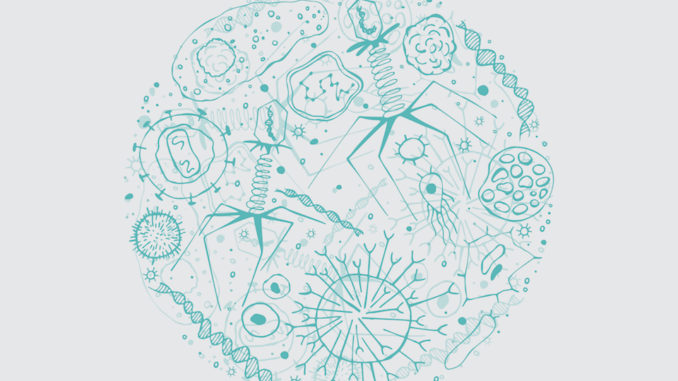
Studies presented at leading microbiome conferences have grown in sophistication over the past several years and have uncovered important mechanistic links between the microbiome and aspects of host health. In fact, certain microorganisms (Akkermansia, Faecalibacterium prausnitzii) have become famous for their beneficial or detrimental effects. But across the field, is this limited approach going to enable scientists to grasp the full complexity of how human microbiomes influence health?
In a recent Nature Medicine Perspective article, Jack Gilbert and Susan Lynch emphasize just how complex human microbiomes are: not only are they highly variable from person to person, but they also exhibit spatial and temporal variation that is likely relevant to their effects on health. Gilbert and Lynch argue,
“…it has become imperative that we embrace a conceptual framework in which findings in the field can be interrogated and interpreted. Community ecology offers such a framework.”
Only a tiny fraction of the 40,000 microbiome studies in PubMed from the past few decades appear to have taken into account the microorganisms’ ecological community context. But this might be set to change.
One of the scientists at the forefront of microbial ecology frameworks in microbiome science is Dr. Isabelle Laforest-Lapointe, Canada Research Chair in Applied Microbial Ecology and Assistant Professor at the Université de Sherbrooke.
Laforest, a plant ecologist turned microbial ecologist with training in statistics and bioinformatics, says despite a history of microbiome studies that focused on different bugs and how they act as individuals, she never saw the microbiome as anything other than an ecosystem.
“I really think about how microbes interact together, how competition and facilitation happen,”
she said in an interview with Microbiome Times editors. Laforest and her fellow ecologists act on the premise that only by understanding the ecology of microbes will microbiome research ever lead to clinically robust interventions that can improve human health. Laforest has worked with immunologist Dr. Marie-Claire Arrieta, who focuses on microbiology and medicine, to explore how the infant human microbiome influences the later development of allergies and asthma. They examined the entire ecosystem of bacteria, fungi, and other microorganisms in early life to discover how they might shape the immune system and later-life disease.
Laforest is optimistic about where the field is going—microbiome scientists tackling the issue of ecology head-on. She says,
“Many things are promising because the researchers are starting to understand the bigger picture. And they’re doing a terrific job, because it’s hard to understand, at this level, how thousands of microorganisms are interacting. We’re not talking about a couple of zebras and lions, we’re talking about organisms that we’re unable to see. And they are really abundant.”
Nevertheless, she says, it’s going to take a significant amount of time and effort before researchers really understand these microbial ecologies and their two-way interactions with the host. Here, she outlines some of the tasks necessary for moving toward an ecological perspective in microbiome science:
1. Adapting definitions from macroecology to microecology
When microbiome scientists use words like ‘resilience’ and ‘resistance’, do they know precisely what they’re talking about? Laforest says more care should be taken to specify how the definitions used in macroecology can be applied to microbiology.
She observes,
“Microbiome researchers are starting to use the ‘buzzwords’ without really defining them and making the transition from macro to micro. This is the reflection they have to start thinking about more. If we use this vocabulary, we have to make sure we can apply them to the microscopic world.”
2. Looking beyond bacteria
The vast majority of microbiome studies to date have focused on bacteria, the most abundant microorganisms in human microbiomes like those of the skin and the gut. But Laforest points out that looking only at the bacterial members of an ecosystem leaves researchers with a major blind spot.
She takes the microbiome of the gut, for example:
“We have to think that bacteria are not the only actors in our gut. Other agents are there like fungi and phages,” she says. “But even if they’re less abundant than bacteria, they can have a huge impact on the ecosystem.”
3. Forming interdisciplinary collaborations
The ability to manipulate a microbiome with precision to have some effect on host health is something of a holy grail in this field of research. Perhaps drawing established ecologists into microbiome studies could help crack the code of how to manipulate microbial communities more effectively.
Says Laforest,
“I think you need people who are able to do interdisciplinary work and help microbiome scientists identify: what are these patterns that we see in bigger communities—which may or may not apply to what they see and can give them hints about how the community is interacting.”
4. Moving from simple to more complex models
Ecology is all about context, and Laforest emphasizes the importance of which model the microbiome researchers use to glean their insights.
“They’re experimenting with biochemistry, they’re experimenting with genes, with mutations. They’re really trying to make an effort in simple models to try to understand from them,” she says. “They eventually have to go into human models, which are way more complicated, to try to mimic the same results: what you see in mice or Drosophilaor C. elegans will probably not happen with humans, or will happen differently.”
5. Using appropriate bioinformatics analyses
Standing in between raw data and actionable insights are the all-important bioinformatics analyses. And since Laforest is trained in bioinformatics and statistics, she is no stranger to the many considerations that go into the choice of analysis.
“Bioinformatics is the most challenging part for anybody that wants to do microbial ecology,” she says. “At every turn you have ten decisions. So you have a couple of mainstream analyses that you can use. But you also have new pipelines that you can use that haven’t been proven but are supposed to be better.”
Each iteration of a study with careful bioinformatics analyses could thus lead to a better grasp of the ecological context.


